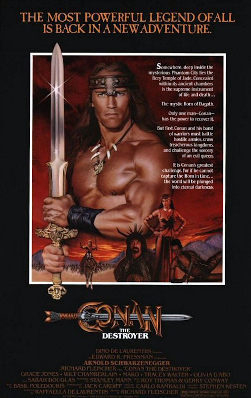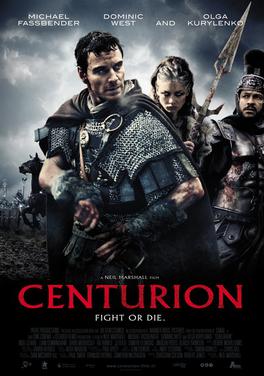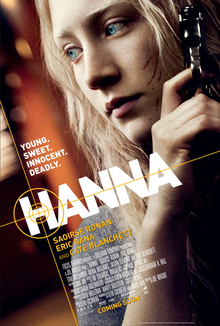So I was pretty delighted when the local semi-arthouse cinema did a one-off screening of Raiders of the Lost Ark (1981). The first of the Lucas-Spielberg films involving Harrison Ford's adventurer archaeologist had been the one I enjoyed least (except for that belated fourth film, which nobody seems to count): I knew it was good, but the earlier incarnation of the franchise couldn't quite match the finely honed machine of Indiana Jones and the Last Crusade (1989). So I watched it again, had an enormous amount of fun and left with a furrowed brow over all the problematic stuff in it.
Set in 1936, the film opens as Dr Henry 'Indiana' Jones (Harrison Ford) is exploring an ancient site somewhere in South America. Improvising his way around wicked traps, Indy manages to snag a golden idol despite the treachery of a local hired hand (Alfred Molina). He promptly finds himself relieved of his prize by his rival, the ruthless French archaeologist Belloq (Paul Freeman), barely escaping with his life. Back in the States, Indy is given a new mission by the secret service. It seems that the Nazis are digging in Egypt, having tasked Belloq with finding the Ark of the Covenant. To reveal its exact location, though, they need the Staff of Ra, which is in the possession of Indy's old patron Abner Ravenwood, last known location...
... Nepal, where after Abner's death his daughter Marion (Karen Allen) keeps the headpiece of the staff. The problem: Marion is none too keen on Indy after he broke her heart ten years previously. Fighting for their lives against goons led by giggling Nazi sadist Major Toht (Ronald Lacey), though, does something to repair the lost trust, and the pair make it to Egypt with the staff. There, they link up with local digger Sallah (John Rhys-Davies) to infiltrate the Nazi excavation, and hopefully locate the Ark before the Führer's men do.
What struck me as a tiresome flaw during a recent viewing of Star Trek Into Darkness is a virtue here: Raiders of the Lost Ark is gloriously propulsive, barely letting up from start to finish. Even exposition tends to be loaded with background action: take the dinner at Sallah's, where Spielberg and Lucas throw poisoned dates into an already fun dialogue scene. After the US-bound table-setting the film does not slow down until the dénouement, although Lawrence Kasdan - he of The Empire Strikes Back - is a smart enough writer that by the time the relentless action scenes finally get a little wearying, he switches to a lower gear so that the film's climax is heavy on tension but light on fisticuffs.
 |
| The film's idea of appropriate race relations. |
The cast is uniformly great. Harrison's perpetually exasperated adventurer archaeologist is of course iconic, played here perhaps with a little more meanness than in subsequent offerings; Denholm Elliott's Marcus Brody is such a delight that it's no surprise Last Crusade expanded his role. I must admit I have a massive fictional-character crush on Allen's Marion, and I hope my judgment is not too terribly clouded by that, but: what a fantastic character! When introduced, at least: Marion drinking a local under the table, then holding her own in a battle against Toht's henchmen is pretty awesome. Unfortunately, Kasdan's screenplay proceeds to defang her. Being put into dresses, in fact, becomes a plot point, and she's an increasingly distressed damsel relying on Indy for rescue and basic common sense.
That's the real problem with Raiders of the Lost Ark: based on 1930s adventure serials, the film somehow sees fit to just bring in all the racism and misogyny of that period instead of challenging it. Marion's demotion is the least of it, alas. The film's racism is ugly and pervasive. Indiana Jones and the Temple of Doom takes a lot of flak for racism, and deservedly so; but its predecessor is no better by any real yardstick. Its non-white people, to be sure, are not crazed murdering cultists: they are mostly childlike innocents requiring the kind guidance of the white man. A narrative in which white people are masters and Egyptians mere labourers is never seriously challenged (see the image above). Worse, the ambiguous South Americans are treacherous, lazy and cowardly and, in the case of the indigenous warriors Belloq has allied himself with, primitive and superstitious. It's totally unnecessary and leaves a terrible aftertaste.
Despite that, too, being mostly associated with its immediate successor, Raiders is pretty brutal, featuring multiple unpleasant deaths, mostly bloodless though they may be (and in one infamous scene involving a Nazi bare-knuckle boxer and an aeroplane propeller, it's decidedly not bloodless). There's violence against animals as well, including a whole mess of snakes being doused with petrol and set on fire, and an unfortunate monkey. It's better than an Italian cannibal film inasmuch as it's not real, I suppose, but far from pleasant or called for. Like Tintin in the Congo, Raiders presents the killing of animals is harmless entertainment, and the thought that it might be something else never crosses the film's mind.
If that doesn't sour your appreciation, though, Raiders of the Lost Ark is overflowing with joys. Norman Reynolds's production design is just wonderful: the Ark marries an ancient feel with art-déco chic in just the right way, while the South American temple is a laundry list of wonderfully executed tropes. (Who doesn't love ancient traps?) More than anything, it shows what the people involved were best at: Spielberg, at being the greatest blockbuster director of his generation; Kasdan, at marrying drama and action-comedy; and Lucas, at taking a step back and using his genius for production without directing himself, a lesson he sadly did not heed in later years (see also: Jackson, Peter).
It's such a delightful film that its less savoury aspects are a whole lot easier to overlook than they might be. With the double-whammy of Empire and Raiders, Kasdan clearly had a winning streak in the first half of the eighties (even Return of the Jedi, weighed down by merchandise-friendly teddy bears and material rehashed from Star Wars, is ultimately well-written, devastatingly so in some scenes). Raiders of the Lost Ark is tremendously good fun: populist but not stupid, hilarious without being tasteless, and action-packed without directing that violence at the audience in the manner of twenty-first-century action films.


























